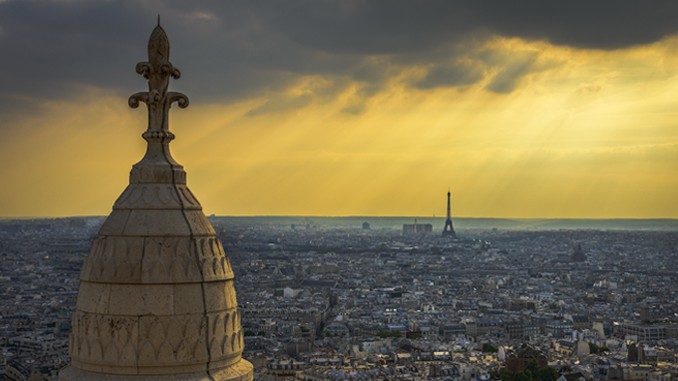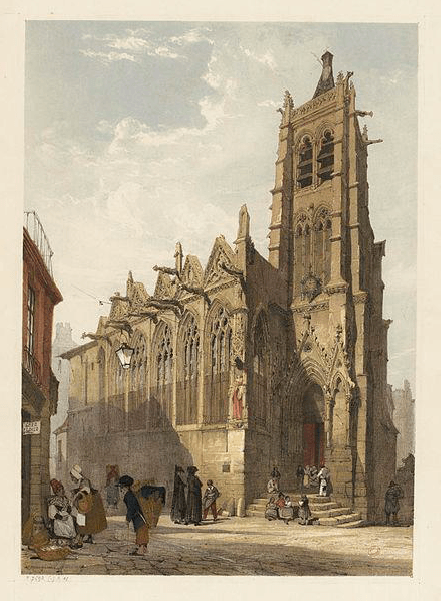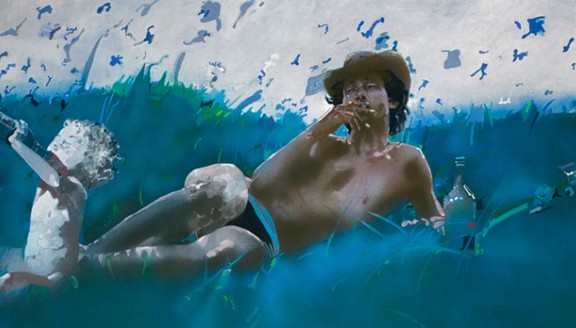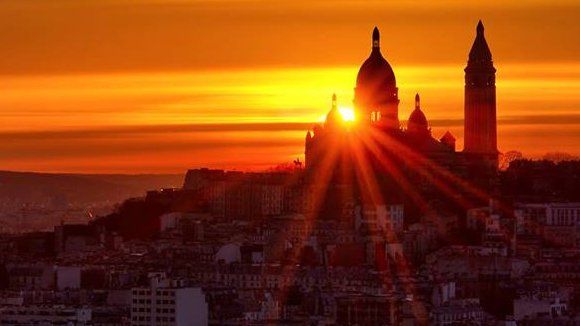
Paris has almost two hundred Christian places of worship, including over one hundred and twenty Catholic churches. Once, their number was much greater, but the modernizers of the French capital – from the Jacobins and Napoleon to Baron Haussmann – diminished it substantially. In the second half of the 19th and at the beginning of the 20th century, this loss had been somewhat made up by the construction of many new, architecturally important churches, especially of the emblematic Sacré-Cœur Basilica at the summit of the Montmartre hill. However, at present, the old Parisian temples are being destroyed again, the latest example of which is the church of Sainte-Rita, the site of the annual blessing of house pets.
The churches of Paris differ in at least one important respect from their counterparts in Italy, Spain or Poland. They seem almost empty due to the scant presence of side altars, sculptures, paintings, and tombs. This is, again, a result of the modernizing efforts whose beginnings go back to the early 18th century (and the impact of which, on the Notre-Dame Cathedral, Victor Hugo lamented so eloquently in his eponymous novel). Antireligious vandalism of the French Revolution also played a very large role in this despoliation. On the other hand, we cannot ignore the specifically French taste, in which less is often more. Despite all this – and perhaps exactly because of it – many churches in the City of Lights have a characteristic and unique atmosphere.
Between going up the Eiffel Tower and rushing through the Louvre Museum, an average tourist has only enough time to make a quick stop at the cathedral of Notre-Dame and, perhaps, at the fairytale-like Sainte-Chapelle. I was in a better situation. In the late spring of 2011, I spent two very hot weeks walking for at least seven hours daily, sans haste, all over Paris. I visited its museums, archives, cemeteries, and especially its churches. The videos presented below are one of the results of that stay. More impressionistic than documentary, they try to reflect the specific climate of Parisian churches and point out several hidden treasures, such as the church of Les Carmes with its macabre display of skulls and bones belonging to the priests murdered there during the September Massacres in 1792, or the Picpus chapel and cemetery with the mass graves of the guillotined victims of the Terror (both in part three).
But let the movies speak for themselves. Enjoy!
.
Churches of Paris 1: The oldest buildings
The opening part of this documentary mini-series shows the three oldest Parisian churches, namely, the abbatial church of Saint-Germain-des-Prés (whose 11th-century bell tower is the oldest existing ecclesiastical structure in Paris) with the tombs of the ex-King of Poland John Casimir Vasa and the philosopher Rene Descartes; the 12th-century Saint-Pierre-de-Montmartre, and the famous Saint-Julien-le-Pauvre, the grounds of which enclose the oldest tree still growing in Paris (a locust tree, planted in 1601), and a miraculous well. They also offer the best view of the Notre Dame Cathedral on the opposite bank of the Seine. Copyright-free music by Kevin MacLeod and Jimmy Gelhaar.
.
Churches of Paris 2: From Gothic to Rococo
The Saint- Séverin church, one of the most atmospheric churches in Paris, contains the famous “palm grove” behind the main altar and a marble side altar on which a Satanist black mass has been celebrated in the times of Louis XIV. It also has a replica of the Our Lady of the Gate of Dawn (Matka Boska Ostrobramska) icon from Vilna, donated by a Polish mystic Andrzej Towianski. Saint-Étienne-du-Mont, located near the Pantheon, is famous for its rood screen (the only one left in Paris), the remains of the tomb of Saint Genevieve, the patron saint of Paris (destroyed during the Revolution), a series of the 17th-century “alchemical” stained-glass windows, and the tombs of Blaise Pascal and Jean Racine. Saint-Germain-l’Auxerrois, next to the Louvre, was the royal church, and its bell gave the signal to start the St. Bartholomew’s Day Massacre on August 23rd, 1572. Saint-Eustache is a huge Late Gothic pile adjoining the site of the famous Parisian market Les Halles (now lamentably gone); I consider it more impressive than the cathedral of Notre Dame. It contains beautiful stained-glass windows, the largest pipe organ in France, and a modern sculpture showing the merchants of Les Halles leaving their stalls for the last time on February 28th, 1969. The church of Saint-Gervais-et-Saint-Protais displays Renaissance wooden choir stalls with allegorical carvings. The Saint-Paul-Saint-Louis church in the Marais district is a beautiful example of the French Baroque architecture; it contains Eugene Delacroix’s painting “Christ in agony on the Mount of Olives.” Saint-Nicolas-du-Chardonnet is mostly famous for its takeover by the traditionalist Society of St. Pius X in 1977. Finally, the late Baroque church of Saint-Roch (with a Rococo interior) has been at the center of many violent events during the French Revolution, including General Bonaparte’s “whiff of grapeshot”; Pierre Corneille, the leading dramatist, and André Le Nôtre, the famous landscape architect of Louis XIV, are buried there. Copyright-free music by Kevin MacLeod and Jimmy Gelhaar.
.
Churches of Paris 3: Victims of the French Revolution
This part shows three Parisian churches related to the victims of the French Revolution: the St-Joseph-des-Carmes where a massacre of the imprisoned priests occurred on September 2nd, 1792 (the bones of the martyrs and other relics are preserved in the church); the Notre-Dame-de-la-Paix-de-Picpus with the full list of 1,306 persons guillotined in 1794 at the nearby Place de la Nation (then the Place du Trone-Renverse), who were then buried in two great pits at the church’s cemetery; and the Chapelle Expiatoire (the Expiatory Chapel) built in 1816-26 on the grounds of the former Madeleine cemetery where the bodies of Louis XVI and Marie Antoinette had been buried (the site also includes mass graves of the Royal Swiss Guards murdered and mutilated by the Parisian mob after the storming of the Tuileries palace on August 10th, 1792. Copyright-free music by Kevin MacLeod and Jimmy Gelhaar.
.
Churches of Paris 4: Napoleonic glories
The church of La Madeleine was originally designed by Napoleon as a monument to the glory of his Grande Armée; after a long and complicated history, it became a Catholic church in 1842. It is one of the most monumental buildings in Paris. Saint-Louis-des-Invalides, located on the other side of Napoleon’s tomb at the Hôtel des Invalides (now an important military museum), contains burials of several Napoleonic marshals and the enemy standards captured by the French armies after 1815. It carries the ecclesiastical rank of a cathedral of the French military forces. Copyright-free music by Kevin MacLeod and Jimmy Gelhaar.
.
Churches of Paris 5: Martyrs, miracles, and missionaries
On May 26th, 1871, the communards massacred a group of 51 hostages (including eleven priests) in the courtyard of the building at no. 51, rue Haxo. In 1938, the church of Notre-Dame-Des-Otages was erected next door, in the Art Deco style. The famous Chapel of Our Lady of the Miraculous Medal (La chapelle Notre-Dame de la Médaille miraculeuse), located at 140 rue du Bac, bears witness to a series of Marian apparitions at this spot in 1830, and is a thriving pilgrimage centre. A few houses away, at 128 rue du Bac, stands the Chapelle de l’Épiphanie which houses a unique museum with original specimens of not only priestly vestments and ritual paraphernalia used by the French Catholic missionaries in the Far East but also chains, wooden restraints and executioner’s weapons, the tools of their martyrdom. Copyright-free music by Kevin MacLeod and Jimmy Gelhaar.
..
Mariusz Wesołowski
July, 2017
..
Illustration: Thomas Shotter Boys, The church of St- Séverin in Paris, lithograph, 1839
..
O autorze:
 Mariusz Wesolowski – (ur. 1954), absolwent polonistyki i historii sztuki Uniwersytetu Jagiellońskiego, od roku 1982 mieszka w Kanadzie.
Mariusz Wesolowski – (ur. 1954), absolwent polonistyki i historii sztuki Uniwersytetu Jagiellońskiego, od roku 1982 mieszka w Kanadzie.





A beautiful Neo-Gothic church in France is being demolished to make room for a parking lot: https://churchpop.com/2017/07/24/church-france-demolished/